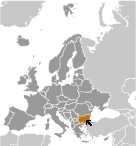World Atlas: Bulgaria. On this page you can see the map, country flag and many detailed information about the people, history and economy of Bulgaria.

Here you can find online selected information about the geography, inhabitants, government, economy and history of Bulgaria. Included are selected statistics, an overview map and the detailed map of Bulgaria. But let's start with the flag of Bulgaria here:
Bulgaria - Overview:
What you should know about Bulgaria? Let's start with this: The Bulgars, a Central Asian Turkic tribe, merged with the local Slavic inhabitants in the late 7th century to form the first Bulgarian state. In succeeding centuries, Bulgaria struggled with the Byzantine Empire to assert its place in the Balkans, but by the end of the 14th century the country was overrun by the Ottoman Turks. Northern Bulgaria attained autonomy in 1878 and all of Bulgaria became independent from the Ottoman Empire in 1908. Having fought on the losing side in both World Wars, Bulgaria fell within the Soviet sphere of influence and became a People's Republic in 1946. Communist domination ended in 1990, when Bulgaria held its first multiparty election since World War II and began the contentious process of moving toward political democracy and a market economy while combating inflation, unemployment, corruption, and crime. The country joined NATO in 2004 and the EU in 2007.
Geography of Bulgaria
 Where on the globe is Bulgaria? The location of this country is Southeastern Europe, bordering the Black Sea, between Romania and Turkey. Total area of Bulgaria is 110,879 sq km, of which 108,489 sq km is land. So this is not a large country. How could we describe the terrain of the country? This way: mostly mountains with lowlands in north and southeast. The lowest point of Bulgaria is Black Sea 0 m, the highest point Musala 2,925 m. And the climate is temperate; cold, damp winters; hot, dry summers.
Where on the globe is Bulgaria? The location of this country is Southeastern Europe, bordering the Black Sea, between Romania and Turkey. Total area of Bulgaria is 110,879 sq km, of which 108,489 sq km is land. So this is not a large country. How could we describe the terrain of the country? This way: mostly mountains with lowlands in north and southeast. The lowest point of Bulgaria is Black Sea 0 m, the highest point Musala 2,925 m. And the climate is temperate; cold, damp winters; hot, dry summers.
Inhabitants of Bulgaria
Let's take a look how many people live in Bulgaria. The number is: 7,101,510 (July 2017 est.). So this is not very populous country. Who lives here? Bulgarian 76.9%, Turkish 8%, Romani 4.4%, other 0.7% (including Russian, Armenian, and Vlach), other (unknown) 10% (2011 est.). What are the languages in Bulgaria? Bulgarian (official) 76.8%, Turkish 8.2%, Romani 3.8%, other 0.7%, unspecified 10.5% (2011 est.). And the religions: Eastern Orthodox 59.4%, Muslim 7.8%, other (including Catholic, Protestant, Armenian Apostolic Orthodox, and Jewish) 1.7%, none 3.7%, unspecified 27.4% (2011 est.). How old are the people in average? 42.7 years. We have to add that this number is the median - so one half of the people is older than this, one half is younger. And what is their life expectancy (at birth)? This: 74.7 years. Where the people live in Bulgaria? Here: a fairly even distribution throughout most of the country, with urban areas attracting larger populations. The major urban areas of Bulgaria are: Sofia (capital) 1.226 million (2015).
Government and Economy of Bulgaria
The capital of Bulgaria is Sofia and the government type parliamentary republic. Let's take a look at the administrative divisions - 28 provinces (oblasti, singular - oblast); Blagoevgrad, Burgas, Dobrich, Gabrovo, Haskovo, Kardzhali, Kyustendil, Lovech, Montana, Pazardzhik, Pernik, Pleven, Plovdiv, Razgrad, Ruse, Shumen, Silistra, Sliven, Smolyan, Sofia, Sofia-Grad (Sofia City), Stara Zagora, Targovishte, Varna, Veliko Tarnovo, Vidin, Vratsa, Yambol. Regarding the economy of Bulgaria, important industrial products are electricity, gas, water; food, beverages, tobacco; machinery and equipment, automotive parts, base metals, chemical products, coke, refined petroleum, nuclear fuel; outsourcing centers. Important agricultural products are vegetables, fruits, tobacco, wine, wheat, barley, sunflowers, sugar beets; livestock. The most important export commodities are clothing, footwear, iron and steel, machinery and equipment, fuels, agriculture, tobacco, IT components and the most important export partners are Germany 13.7%, Italy 9.3%, Romania 8.8%, Turkey 7.9%, Greece 7%, France 4.5% (2016). The most important import commodities are machinery and equipment; metals and ores; chemicals and plastics; fuels, minerals, and raw materials and the most important import partners are Germany 13.1%, Russia 8.9%, Italy 7.9%, Romania 7%, Turkey 6.2%, Greece 4.8%, Poland 4.1% (2016). How rich is Bulgaria and how rich are people in this country? The most important number here is GDP per capita (PPP): $21,600 (2017 est.). This means the living standards are good here. Let's add that this means Gross Domestic Product per person, which is recalculated with respect to the relative cost of local goods and services. And one more important number - population below poverty line: 22% (2015 est.).